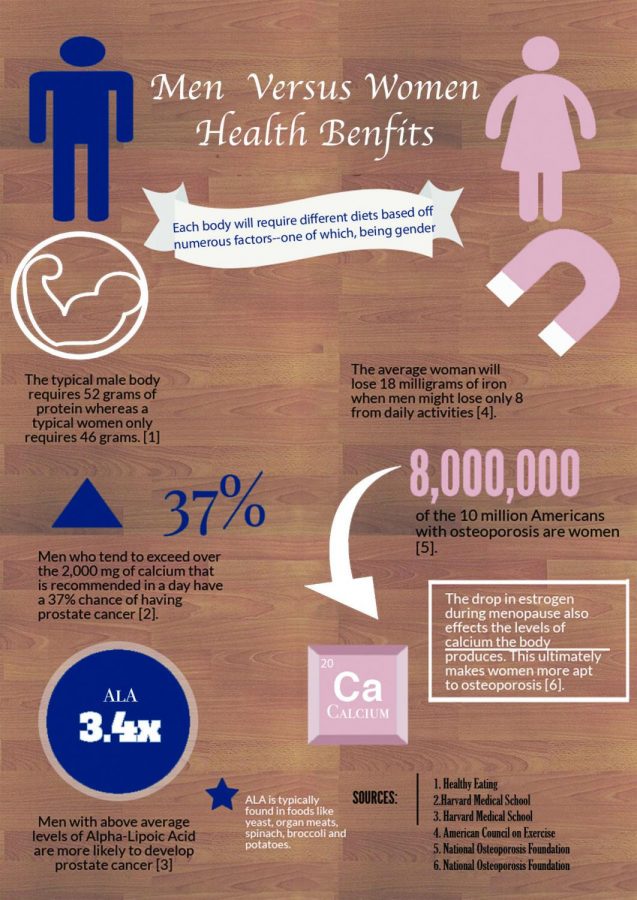Men and women’s needs are distinctively different
There is a large difference between health and nutritional demands for both genders. These developmental differences require distinction.
Men vs Women Info graphic outlines the health benefits of each gender
March 28, 2019
Boys and girls oftentimes require different nutritional needs in order to properly develop as they begin to blossom into young adulthood.
For many young people, nutrition is as easy as eat when you are hungry, drink when you’re thirsty and occasionally, order a double fry. However, the way bodies are properly nourished is not as broad as some may think.
The developments between men and women require different diets to cater towards these developments. Head of the Nutrition Department at Southern Methodist University, Danielle Hurtado, gave her professional opinion on how to account for the bodies’ various changes between sexes.
“A girls period is going to be the one outstanding factor,” Hurtado said.
Girls endure a monthly menstrual cycle to prepare their uterus for children. In this process, the hormonal balance is completely off kilter, leaving women in various states of emotional imbalance, otherwise known as PMS. The weeks leading up to a woman’s period are likely to cause serotonin levels to decrease, this being the ‘happy chemical’ in everyone’s brain. Gynecologist, Tanya Tindell, explained the deeper effect that periods can have on young girls.
“[‘PMSing’] happens to find its way as the butt of every period joke but, it does have very real consequences on the female body and mind,” Tindell said.
In order to counteract this feeling of moodiness or depression that the lack of serotonin may cause, many women’s bodies begin to crave sugar and carb-filled foods. The body processes carbohydrates to produce serotonin so it would only make sense for the supply of carbs to attempt to fulfill the demand of the body.
The female body’s dietal demands caused by periods also requires a rebalancing of iron levels post-period because of blood lost.
According to the American Council on Exercise, an average of 18 milligrams of iron is lost for each day a woman is on her menstrual cycle compared to the mere eight milligrams a man might lose from everyday life. This can be incredibly problematic considering iron is primarily used for red blood cell production that carries oxygen throughout the body.
University of Oregon nutritionist, Nikki Jupe, shared the day to day effects that low iron could have on a person’s disposition.
“Iron and fatigue are inversely related,”
Jupe said. “You’ll be tired all day, unfocused and high intensity workouts might become harder to do.”
To account for the body’s iron loss many women may need to consume more red meats and seafood post-period.
Following menopause, a woman’s decline in reproductive hormones, the body produces very little estrogen compared to earlier in life.
This would seem fine considering older women are not typically wanting to have more children but, estrogen is also responsible for the body’s calcium composition. Calcium being primarily responsible for keeping bones healthy and dense in order to prevent easy fractures and osteoporosis. Many health professionals rightfully implore women to increase their calcium intake with dairy and leafy greens. However Hurtado explained that body composition sometimes goes beyond boy versus girl.
“Osteoporosis due to calcium deficiency is a very real problem but, tends to only be heavily seen in white women,” Hurtado said. “For some reason, this problem does not have as heavy as an impact black and hispanic communities, these women’s bones we find are a lot denser.”
When it comes to the nutrition a man might need, Jupe pointed out the complexities of nutrition, considering there is not a baseline similarity between all men like women with their periods.
“Nutrition is not as black and white as boy and girl.” Jupe said “What a male office job and a girl powerlifter need are going to differ drastically.”
The typical statement about men’s health is simply more, more and more to meet this vast caloric intake men are perceived to have.
According to Healthy Eating men generally require more protein, needing an average of 52 grams a day where women only require 46 grams. The need for this extra protein is attributed to the larger muscles and body mass men typically have.
However, the desired amount of this caloric intake and grams of protein varies drastically between men, because there are so many different variations of health needs. The needs of young athletes are not going to be similar to the needs of older sedentary workers, specificity is key.
“Nutrition, in some cases, is not very broad, if you want to know your body tests are available to do so,” Jupe said.
These tests break down exactly how much protein, iron or vitamin D a male body needs based off of their specific lifestyle.
As young adults are blossoming into adulthood it is becoming increasingly more important to know one’s own body and cater to those needs, not blanket guidelines.








